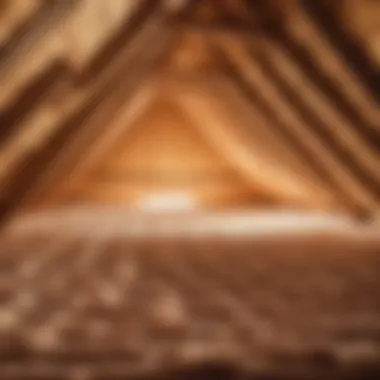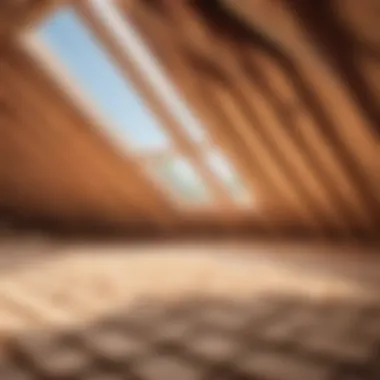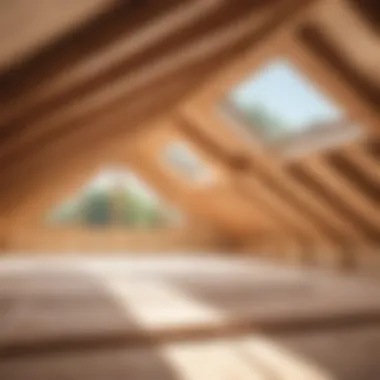Maximizing Energy Efficiency: The Complete Guide to Attic Roof Insulation Costs and Benefits


Materials:
- Fiberglass insulation rolls: 100 feet x 15 inches x R-30
- Utility knife with sharp blades for cutting insulation
- Safety goggles and gloves for protection
- Insulation support rods to hold insulation in place
- Tape measure for accurate sizing
- Caulk or foam sealant to seal gaps
- Attic baffles for proper ventilation
DIY Steps:
- Measure the attic space carefully to determine the amount of insulation needed. Ensure accurate measurements for a proper fit.
- Put on safety goggles and gloves before handling insulation material. Safety is crucial during this process.
- Cut fiberglass insulation rolls to the required length using a utility knife. Make precise cuts to fit the attic space.
- Place insulation support rods between ceiling joists to hold the insulation in place securely. This prevents sagging over time.
- Install attic baffles to maintain proper ventilation and avoid blocking airflow. This is essential for energy efficiency.
- Use caulk or foam sealant to seal any gaps or cracks in the attic walls or ceiling. This helps to improve insulation effectiveness.
Technical Aspects:
- Timing: Allocate a full day for the insulation project to ensure thorough completion.
- Tools: Apart from the ones mentioned, also require a staple gun for securing insulation.
- Critical Techniques: Ensure uniform coverage and proper alignment of insulation to maximize effectiveness.
DIY Project Process:


- Start by measuring and cutting insulation rolls to fit the attic space accurately.
- Place insulation support rods and attic baffles for structural support and ventilation.
- Install insulation between ceiling joists, ensuring full coverage without compression.
- Seal any gaps or cracks with caulk or foam sealant to enhance insulation properties.
- Troubleshooting Tips: In case of sagging insulation, add more support rods for reinforcement and fluff out insulation for better coverage.
The ultimate goal of insulating attic roofs is to improve energy efficiency, enhance home comfort, and reduce utility costs. By following these meticulous steps and using high-quality materials, homeowners can achieve optimal insulation results for their attic spaces.
Introduction


In this section, we will delve into the crucial aspect of attic insulation, a key component of a home's energy efficiency and comfort. Attic insulation plays a pivotal role in regulating indoor temperature and reducing energy consumption. By ensuring proper insulation, homeowners can create a more sustainable living environment while lowering utility costs. This article will explore the various elements associated with attic insulation, from materials to installation methods, providing readers with essential knowledge to make informed decisions.
Overview of Attic Insulation
Significance of Attic Insulation
Attic insulation holds immense significance in maintaining a home's energy efficiency levels. By preventing heat transfer between the interior and exterior of a house, attic insulation helps in keeping the living spaces comfortable throughout the year. The key characteristic of attic insulation lies in its ability to act as a barrier against heat loss in winter and heat gain in summer. This thermal resistance is instrumental in reducing the workload on HVAC systems, leading to lower energy bills and a decreased carbon footprint. While attic insulation may require an initial investment, its long-term benefits far outweigh the costs, making it a prudent choice for homeowners seeking enhanced energy performance in their homes.
Impacts on Energy Efficiency
The impact of attic insulation on energy efficiency cannot be overstated. By effectively insulating the attic space, homeowners can significantly reduce the amount of energy required to heat or cool their homes. This results in lower energy consumption, leading to cost savings and environmental benefits. Attic insulation acts as a key preventive measure against energy waste, contributing to a more sustainable lifestyle. Its role in improving energy efficiency makes it a popular choice among homeowners looking to optimize their home's overall performance and minimize their ecological footprint.
Types of Attic Insulation Materials
Fiberglass Insulation
Fiberglass insulation is a versatile and widely used material in attic insulation projects. Its key characteristic lies in its thermal performance and cost-effectiveness, making it a popular choice for many homeowners. Fiberglass insulation is known for its fire resistance properties and ease of installation, offering a durable solution for enhancing a home's energy efficiency. However, it is essential to handle fiberglass insulation with care due to its potential health risks if not properly managed. Despite this drawback, fiberglass insulation remains a top choice for homeowners seeking an efficient and budget-friendly insulation option.
Cellulose Insulation
Cellulose insulation is another prevalent material used in attic insulation, prized for its eco-friendly composition and excellent thermal performance. The key characteristic of cellulose insulation lies in its sustainable nature, as it is primarily composed of recycled paper materials. This makes it a popular choice among environmentally conscious homeowners looking to reduce their ecological impact. Cellulose insulation offers a high level of thermal resistance, providing effective heat flow control and enhancing overall energy efficiency. While cellulose insulation may require professional installation to ensure proper coverage and performance, its numerous benefits make it a preferred choice for those prioritizing sustainability in their insulation projects.
Spray Foam Insulation
Spray foam insulation is a cutting-edge solution for attic insulation, known for its superior thermal performance and air sealing properties. The key characteristic of spray foam insulation lies in its ability to expand and fill all gaps and air leaks, creating a seamless barrier against heat transfer. This feature makes spray foam insulation highly beneficial for maintaining consistent indoor temperatures and reducing energy waste. While spray foam insulation installation may be more complex and costly than other materials, its long-term efficiency and air sealing capabilities make it a valuable investment for homeowners seeking peak energy performance in their homes.
Factors Affecting Insulation Costs


In this comprehensive guide to insulating attic roofs, understanding the factors that impact insulation costs is crucial. The cost considerations play a significant role in deciding the type of insulation that best suits your attic space. By delving into these factors, you can make informed decisions that align with your budget and long-term efficiency goals. Analyzing the various elements that influence insulation costs helps homeowners optimize their investment and reap the benefits of a well-insulated attic.
Size and Layout of the Attic Space
Square Footage
When considering the size and layout of the attic space, square footage emerges as a pivotal factor affecting insulation costs. The total square footage determines the amount of insulation material required for adequate coverage. Larger attic spaces necessitate more insulation, leading to higher material costs. However, optimizing insulation based on the square footage results in improved energy efficiency and enhanced comfort levels within the home.
The key advantage of focusing on square footage is the precision it offers in estimating material needs, minimizing wastage, and maximizing insulation effectiveness. By tailoring the insulation depth to the square footage, homeowners can achieve optimal thermal performance while controlling costs efficiently.
Roof Slope
Another essential aspect influencing insulation costs is the roof slope. The steepness of the roof affects the complexity of installation and the amount of insulation material needed. Attics with steeper slopes may require specialized installation techniques and potentially higher material expenses. However, the unique feature of roof slope lies in its contribution to effective moisture control and ventilation within the attic space.
While a steep roof slope may entail higher costs upfront, its advantages in long-term energy savings and enhanced insulation performance make it a valuable choice for homeowners investing in attic insulation. By considering the roof slope during the insulation planning phase, you can tailor the project to suit the specific needs of your attic space and maximize the benefits of a well-insulated roof.
Insulation Material Selection
Cost of Different Materials
When exploring insulation material options, the cost of different materials plays a pivotal role in determining overall project expenses. Each type of insulation material comes with varying costs per square foot, impacting the total investment required for insulation installation. Assessing the cost of different materials allows homeowners to choose a suitable option that aligns with their budget constraints while meeting desired energy efficiency standards.
The key characteristic of evaluating the cost of different materials is the balance between upfront expenses and long-term savings. While some materials may have higher initial costs, their superior insulating properties and durability contribute to increased energy efficiency and lasting insulation performance, leading to significant savings over time.
Long-Term Efficiency
In addition to considering initial material costs, homeowners should prioritize the long-term efficiency of the chosen insulation material. Long-term efficiency factors in the insulation material's durability, thermal performance, and resistance to common issues like moisture and mold. Opting for materials with high long-term efficiency ensures sustained energy savings and insulation benefits over the lifespan of the attic insulation.
The unique feature of focusing on long-term efficiency is the guarantee of consistent insulation performance and minimal maintenance requirements. By investing in materials known for their durability and energy-saving properties, homeowners can enjoy a well-insulated attic that delivers superior comfort and reduced energy costs for years to come.
Labor Costs and Installation Complexity
Professional Installation
Navigating labor costs and installation complexity is essential when planning attic insulation projects. Professional installation services offer expertise, efficiency, and precision in insulating attic roofs. The key advantage of professional installation lies in the quality assurance and optimal coverage achieved through skilled labor. While professional installation may involve higher costs compared to DIY methods, the assurance of expert workmanship and long-term insulation benefits make it a worthwhile investment.
The unique feature of professional installation is the streamlined process and adherence to industry standards, ensuring that the attic insulation is installed correctly and efficiently. By entrusting the project to qualified professionals, homeowners can rest assured that their attic will be insulated to the highest standards, maximizing energy efficiency and long-term savings.
DIY Installation
Alternatively, homeowners can opt for a DIY approach to attic insulation installation to potentially reduce labor costs. DIY installation projects empower individuals to take control of their insulation efforts, learning valuable skills along the way. While DIY methods offer cost savings and a sense of accomplishment, it is essential to consider the complexity of the installation process and potential risks of improper insulation coverage.
The advantage of DIY installation is the hands-on experience and customization options it affords homeowners. By actively participating in the insulation process, individuals can tailor the project to suit their preferences and budget constraints. However, the potential disadvantages of DIY installation include variations in insulation quality and incomplete coverage, which could compromise energy efficiency and insulation performance.
This intricate examination of factors affecting insulation costs offers homeowners a comprehensive understanding of the financial considerations and benefits associated with insulating attic roofs. By delving into the specific elements of attic insulation projects, individuals can make well-informed decisions that optimize energy efficiency, enhance home comfort, and maximize long-term savings.
Calculating the Cost of Attic Insulation
In the realm of insulating attic roofs, understanding and calculating the costs involved are pivotal aspects that demand thorough consideration. The section 'Calculating the Cost of Attic Insulation' within this comprehensive guide serves as a cornerstone in aiding individuals in making informed decisions regarding their insulation investments. By shedding light on various cost factors, this section plays a crucial role in providing a clear picture of the financial implications associated with insulating attic spaces. From material expenses to professional installation costs, calculating the overall budget accurately is essential for individuals looking to optimize their energy efficiency while balancing financial constraints.
Estimating Material Expenses
Cost per Square Foot:
When delving into the realm of material expenses for attic insulation, the 'Cost per Square Foot' holds significant importance as it directly influences the overall budget allocation. This aspect considers the price per unit area of the chosen insulation material, which can vary depending on the type and quality. Opting for an insulation material with a competitive cost per square foot can result in cost-efficiency without compromising on the insulation's effectiveness. It serves as a critical factor in determining the overall expenditure and long-term savings potential of the insulation project, making it a crucial metric in budget planning and decision-making.
Additional Supplies:
Another essential component in estimating material expenses is considering the 'Additional Supplies' required for the insulation installation process. These supplementary materials, ranging from adhesives to protective gear, contribute to the overall cost and efficiency of the insulation project. Selecting the necessary additional supplies with care can streamline the installation process, enhance durability, and ensure the insulation's effectiveness over time. By understanding the unique features and role of additional supplies in boosting insulation performance, individuals can make informed choices regarding their attic insulation investment, optimizing both cost-effectiveness and long-term efficiency.
Professional Installation Costs
Hourly Rates:
Exploring the realm of professional installation costs, 'Hourly Rates' are a fundamental aspect that influences the overall budget allocation for attic insulation. Professional installers typically charge hourly rates for their services, encompassing labor, expertise, and equipment expenses. Understanding the criteria that determine hourly rates, such as complexity of the installation, can aid individuals in assessing the cost-benefit ratio of hiring professionals for the insulation project. While hourly rates contribute to the upfront costs, they also ensure quality installation, adherence to safety protocols, and efficient completion of the insulation project, highlighting the value of professional expertise in achieving optimal insulation outcomes.
Total Labor Charges:
Further dissecting professional installation costs, 'Total Labor Charges' encapsulate the comprehensive expenses associated with hiring professionals for attic insulation installation. These charges extend beyond hourly rates to encompass additional factors like project duration, workforce size, and any unforeseen complexities during installation. By analyzing total labor charges, individuals can gain insight into the overall investment required for professional installation and weigh the benefits of outsourcing the insulation project to experts. While total labor charges contribute to the total expenditure, they signify a commitment to quality workmanship, timely project completion, and adherence to industry standards, underscoring the significance of professional installation in achieving superior attic insulation outcomes.
Benefits of Proper Attic Insulation
Proper attic insulation is a crucial aspect of maintaining a comfortable and energy-efficient home environment. By effectively insulating your attic, you can experience a wide range of benefits that positively impact both your living space and your wallet. Understanding the advantages and considerations of proper attic insulation is essential for homeowners looking to optimize their insulation investments.
Energy Efficiency Improvements
Reduced Heating and Cooling Costs
Reducing heating and cooling costs through proper attic insulation is a primary goal for many homeowners. By ensuring that your attic is well-insulated, you can minimize heat loss in the winter and heat gain in the summer, leading to significant savings on energy bills. The key characteristic of reduced heating and cooling costs lies in the insulation's ability to create a barrier that keeps indoor temperatures stable, reducing the workload on HVAC systems. This efficient insulation choice is beneficial for homeowners seeking long-term cost savings and sustainable energy practices. Additionally, the unique feature of reduced heating and cooling costs is its contribution to overall energy efficiency, making it a practical and popular choice for those looking to maximize insulation benefits.
Environmental Impact
Examining the environmental impact of proper attic insulation reveals its significant contribution to sustainability and energy conservation. By reducing energy consumption through effective insulation, homeowners can lower their carbon footprint and minimize greenhouse gas emissions. The key characteristic of the environmental impact of attic insulation is its role in promoting eco-friendly practices within residential spaces. This insulation choice is not only beneficial for homeowners in terms of energy efficiency but also supports broader environmental conservation efforts. The unique feature lies in how proper attic insulation aligns with green building principles, offering an environmentally conscious solution with long-term advantages for both homeowners and the planet.
Enhanced Indoor Comfort
Ensuring enhanced indoor comfort through proper attic insulation is essential for creating a cozy and consistent living environment. Temperature regulation plays a vital role in maintaining comfortable indoor spaces. By insulating your attic effectively, you can regulate indoor temperatures more efficiently, reducing hot and cold spots within your home. The key characteristic of temperature regulation is its ability to create a balanced thermal environment, enhancing overall comfort for occupants. This beneficial choice in insulation helps homeowners enjoy consistent temperatures throughout their living spaces, promoting a more pleasant and livable home environment.
Moisture Control
Moisture control is another critical aspect of proper attic insulation that contributes to enhanced indoor comfort. By preventing moisture buildup in the attic space, insulation helps protect against mold growth, rot, and structural damage. The key characteristic of moisture control is its role in maintaining optimal humidity levels within the home, safeguarding both the building structure and the health of occupants. This beneficial choice for homeowners ensures a dry and healthy indoor environment, with the unique feature of moisture control providing long-term protection against moisture-related issues. Overall, incorporating effective moisture control measures through proper attic insulation contributes significantly to creating a comfortable and sustainable living space.
Conclusion
In summarizing the intricate realm of insulating attic roofs, it becomes evident that careful consideration of cost and benefits is crucial in achieving optimal energy efficiency and home comfort. The importance of investing in proper attic insulation cannot be overstated, as it not only directly impacts energy consumption but also enhances the overall livability of a dwelling. By meticulously evaluating the size and layout of the attic space, selecting the most suitable insulation material, and factoring in labor costs and installation complexity, homeowners can make informed decisions that lead to long-term savings and environmental sustainability.
Final Thoughts on Attic Insulation
Economic Benefits
When delving into the economic benefits of attic insulation, one must acknowledge its fundamental role in cost-effective energy management. A key characteristic of economic benefits lies in the significant reduction of heating and cooling expenses over time, making it a wise and popular choice for homeowners seeking to optimize their household budgets. The unique feature of economic benefits is the ability to provide a consistent return on investment by curbing energy waste and ensuring efficient temperature regulation throughout the year. While there may be initial costs associated with insulation installation, the advantages of economic benefits far outweigh the drawbacks, making it a financially savvy decision for any household looking to enhance sustainability and reduce utility costs.
Long-Term Savings
Exploring the realm of long-term savings in attic insulation illuminates its crucial role in establishing enduring household affordability and environmental stewardship. The key characteristic of long-term savings lies in the sustainable decrease in energy expenditures as insulated attics retain thermal comfort while minimizing HVAC usage. This feature makes long-term savings a highly sought-after choice for individuals aiming to achieve enduring economic benefits alongside environmental consciousness. The unique aspect of such savings is its exponential growth potential over the years, where the initial insulation investment leads to continuous savings and reduced carbon footprint. While there may be variations in initial outlay based on insulation material and labor costs, the long-term savings surpass these barriers, positioning attic insulation as a prudent long-term investment for both immediate and future financial stability and sustainability.



